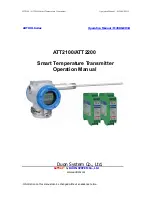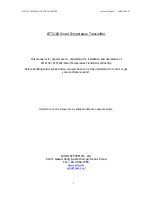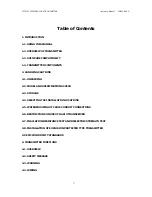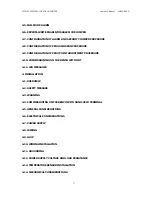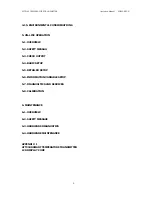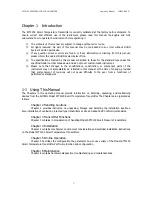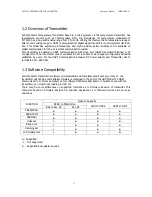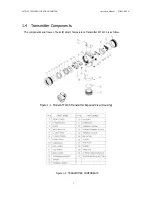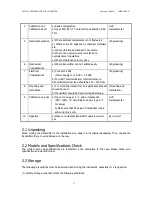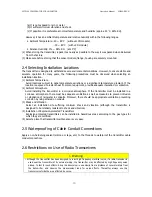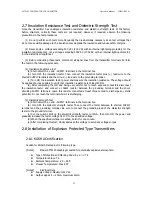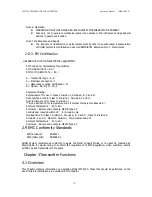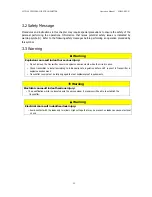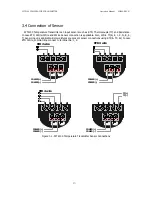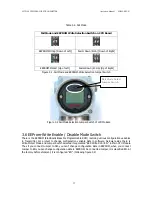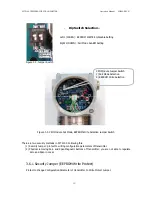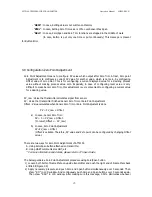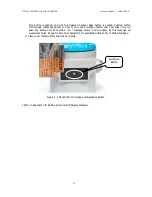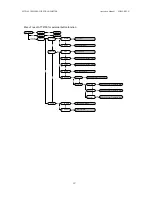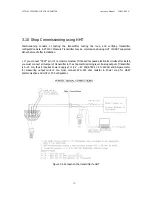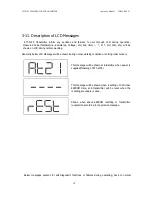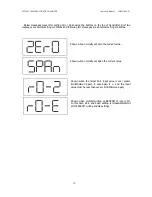
ATT2100 TEMPERATURE TRANSMITTER
Operation Manual M2100-REV-G
11
2.7 Insulation Resistance Test and Dielectric Strength Test
Since the transmitter has undergone insulation resistance and dielectric strength tests at the factory
before shipment, normally these tests are not required. However, if required, observe the following
precautions in the test procedures.
(1) Do not perform such tests more frequently than is absolutely necessary. Even test voltages that
do not cause visible damage to the insulation may degrade the insulation and reduce safety margins.
(2) Never apply a voltage exceeding 500 Vdc (100 Vdc with an internal lightening protector) for the
insulation resistance test, nor a voltage exceeding 500V AC (100V AC with an internal lighting protector)
for the dielectric strength test.
(3) Before conducting these tests, disconnect all signal lines from the transmitter terminals. Perform
the tests in the following procedure.
(4) Insulation Resistance test
(a) Short-circuit the + and - SUPPLY terminals in the terminal box.
(b) Turn OFF the insulation tester. Then connect the insulation tester plus (+) lead wire to the
shorted SUPPLY terminals and the minus (-) lead wire to the grounding terminal.
(c) Turn ON the insulation tester power and measure the insulation resistance. The voltage should
be applied short as possible to verify that insulation resistance is at least 20M
Ω
.
(d) After completing the test and being very careful not to touch exposed conductors disconnect
the insulation tester and connect a 100kW resister between the grounding terminal and the short-
circuiting SUPPLY terminals. Leave this resistor connected at least three second to discharge any static
potential. Do not touch the terminal while it is discharging.
(5) Dielectric Strength Test
(a) Short-circuit the + and - SUPPLY terminals in the terminal box.
(b) Turn OFF the dielectric strength tester. Then connect the tester between th shorted SUPPLY
terminal and the grounding terminal. Be sure to connect the grounding lead of the dielectric strength
tester to the ground terminal.
(c) Set the current limit on the dielectric strength tester to 10mA, then turn ON the power and
gradually increase the tester voltage from '0' to the specified voltage.
(d) When the specified voltage is reached, hold it for one minute.
(e) After completing this test, slowly decrease the voltage to avoid any voltage surges.
2.8 Installation of Explosion Protected Type Transmitters
2.8.1 KOSHA Certification
Caution for KOSHA Flameproof is following type.
[Note1]
Model ATT2100 diaphragm sealed for potentially explosive atmosphere:
Type of Protection and Marking Code: Ex d
Ⅱ
C T6
Temperature Class: T6
Ambient Temperature: -20 ~ 60'C
Process Temperature: Max. 80'C
[Note2] Electrical
Data
Supply Voltage: Maximum 45 Vdc
Output signal: 4 ~ 20mA, maximum 22mA

